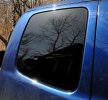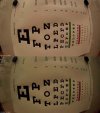Surely normal automatic exposure
should deal with tint without the need for exposure compensation. Reduced light through the tint is exactly the same as if it were a bit darker outside.
It might make it more important to get the exposure right by tweaking the settings, but other than that, I think some people are predicting a problem that doesn't exist.
An analogy: If you put a neutral density filter on an SLR camera set to auto, you will get slower shutter speed and/or wider aperture, but the resulting exposure will be the same.
Edit> Quick test using a Mobius and an ND4 filter. The filter cuts out 75% of light yet the difference is fairly small (25% darker). This may be because the indoor lighting is too dark for the Mobius to cope with after going through the ND4. In daylight there may be no difference.
View attachment 21081
Slow shutter speed and associated motion blur is another matter. Using exposure compensation to brighten the image might actually make that worse.





